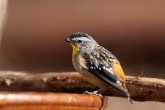Small insect-eating birds
Small insect-eating (insectivorous) birds have been most affected by urbanisation in Australia. Only 15 % of all the species commonly found in cities weigh less than 15 g. This contrasts with birds in native bushland, where around 40 % weigh less than 15 g. In comparison, larger birds dominate cities, with 30 % of species in the 80 g to 200 g weight range; in bushland, less than 10 % of bird species weigh this much.
Why are small birds declining in cities?
Several factors are involved in the loss of small birds from cities. The two most significant factors are:
- Small birds are always vulnerable to predation from larger species. This happens most during the breeding season because eggs and nestlings are unable to escape. Several species of large bird - notably the Pied Currawong - have become more common in cities. They are voracious nest predators and it is likely that Pied Currawongs have an impact on the small birds by limiting their ability to reproduce. Other predatory species, like ravens, butcherbirds and kookaburras, also seem to do well in cities, making life even more dangerous for small birds. One reason that the larger birds do well in cities is that they are more likely to benefit from human-created foods (petfood, garbage, foodscraps and carrion) than small birds, which mostly eat insects.
- Small birds generally can't compete with larger birds for resources. In particular, the Noisy Miner, a common inhabitant of eastern Australian cities, excludes small insectivores (insect-feeders) and nectarivores (nectar-feeders) from its territories. Noisy Miners have become more abundant and widespread in many Australian environments, and are strongly implicated in the loss of small birds from cities.
Related information
- Birds behaving badly: Pied Currawongs
- Birds behaving badly: Noisy Miners
- Birds in Backyards research
Some of our small-insect eating birds include:
| Scientific Name: Anthus novaeseelandiae | Scientific Name: Orthonyx temminckii |
|
|
Scientific Name: Monarcha melanopsis |
| Scientific Name: Gerygone mouki | Scientific Name: Acanthiza pusilla |
| Scientific Name: Falcunculus frontatus | Scientific Name: Epthianura tricolor |
| Scientific Name: Taeniopygia bichenovii | Scientific Name: Melanodryas vittata |
| Scientific Name: Petroica phoenicea | Scientific Name: Pardalotus quadragintus |
| Scientific Name: Pachycephala pectoralis | Scientific Name: Cisticola exilis |
| Scientific Name: Rhipidura albiscapa | Scientific Name: Pomatostomus temporalis |
| Scientific Name: Melanodryas cucullata | Scientific Name: Acanthiza apicalis |
| Scientific Name: Microeca fascinans | Scientific Name: Sericornis magnirostra |
| Scientific Name: Myiagra rubecula | Scientific Name: Megalurus gramineus |
| Scientific Name: Gerygone levigaster | Scientific Name: Pachycephala olivacea |
| Scientific Name: Tregellasia capito | Scientific Name: Petroica rodinogaster |


































